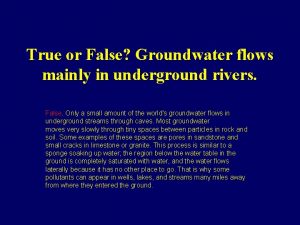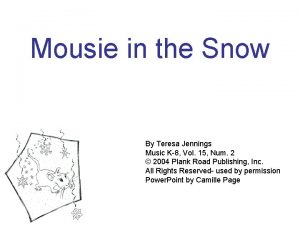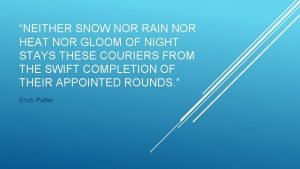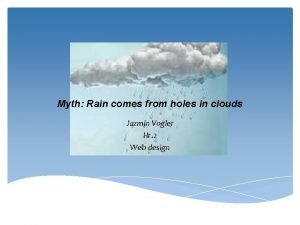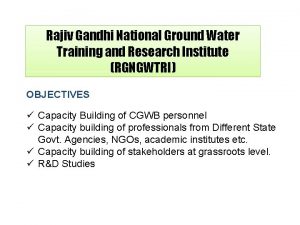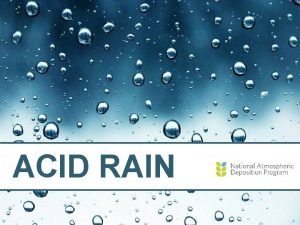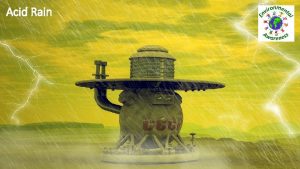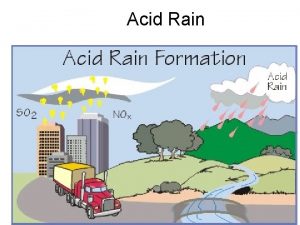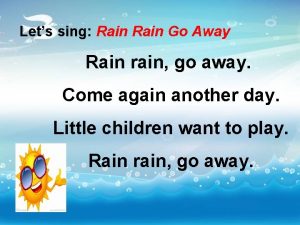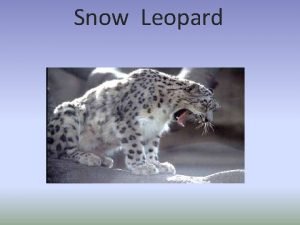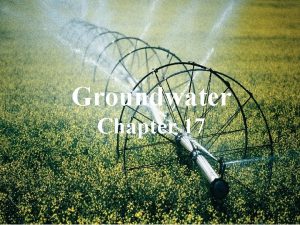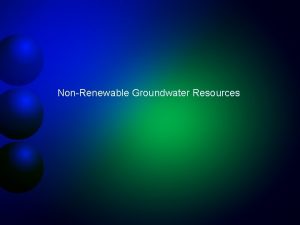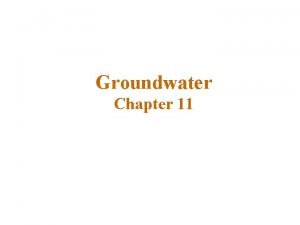Ch 14 Groundwater Groundwater comes from rain snow













- Slides: 13

Ch. 14 Groundwater

Groundwater comes from rain, snow, sleet, and hail that soaks into the ground. Water moves due to gravity, passing between particles of soil, sand, gravel, & rock until it reaches a depth where the ground is filled with water. Area filled with water is the saturated zone & above this is the water table.

Porosity: amount of space between grains of soil, rock or sand. Permeability: rate which water passes through the pore spaces

Water table: area above where all pore spaces are filled with water. Atop the zone of saturation. Zone of aeration: area between water table and ground surface where air may be present. • Capillary fringe: attraction between water and soil particles.

Aquifers are underground formations of porous or permeable rock and loose materials, such as sand. They can be very small, but many go to hundreds of meters thick. Although the water in aquifers flows, it is not an underground river http: //www. challenge. nm. org/archive/00 -01/Final. Reports/013

The Albuquerque aquifer spans from Cochiti Reservoir, downstream to San Acacia in the south. • ~ 100 miles long, 25 -40 miles wide. • Ranges in thickness anywhere from 5 meters to 14, 000 meters. • Called an unconsolidated sand gravel aquifer. Made of sand & other very porous materials, allowing it to flow and percolate relatively easily. • unconfined aquifer: the ‘water table’ is able to rise and fall. • basin-fill aquifer, the Rio Grande Valley forces surface water to flow into the river, where it can then recharge the aquifer. • We remove water from our aquifer by pumping it out, yet rely on natural means to recharge the groundwater supply. Because of this, little of what we take out manages to make it back in. http: //www. challenge. nm. org/archive/00 -01/Final. Reports/013/

Ordinary well: human created by digging to water table and pumping water to the surface. Spring: groundwater flows to the surface unaided. Artesian wells: formed in broken rock and filled by precipitation. Water moves by pressure, requiring no pumping.

Hot springs, geysers and fumaroles: geologic features which release hot ground water. • Heated by magma contact or originating from deep within the earth.

Water Budget • Discharge: water exits an aquifer. • Recharge, enters the aquifer by seeping down from bodies of water or from the surface, or through a process called injection, where it is pumped artificially back into the aquifer through wells. • Drawdown: water removed but not replenished. http: //www. challenge. nm. org/archive/00 -01/Final. Reports/013/

Groundwater dissolves minerals as it percolates through soils. • Minerals are responsible for hard water content. • Deposits left when water evaporates creates mineral veins of gold, silver and other elements.

Mineral springs commonly become health resorts for the benefits of the chemical composition of the groundwater. Caverns frequently formed in areas of limestone bedrock as water dissolves the rock.


Sinkholes form when CO 2 in water dissolves rock beneath the soil. Karst topography describes regions known for sinkholes, lost rivers & areas of underground drainage.
 True or false: groundwater can flow.
True or false: groundwater can flow. Rock n roll snowman
Rock n roll snowman Snow snow snow teresa jennings
Snow snow snow teresa jennings A little a few a lot of much many
A little a few a lot of much many Sleet hail snow rain
Sleet hail snow rain Low-lying clouds that produce rain and snow
Low-lying clouds that produce rain and snow It's more than just rain or snow
It's more than just rain or snow Snow + rain = sleet maths problem
Snow + rain = sleet maths problem Neither snow nor rain nor heat
Neither snow nor rain nor heat Isaac asimov rain rain go away
Isaac asimov rain rain go away Here comes the snow music k8
Here comes the snow music k8 How the rain comes
How the rain comes First comes love then comes marriage
First comes love then comes marriage Rajiv gandhi groundwater raipur
Rajiv gandhi groundwater raipur
